As a homeschooling mom, I know how hard it can be to fit everything in during the day. There is so much you want to teach your children and never enough time! But the truth is, you don’t have to do it all and you shouldn’t. In this post, I’ll be sharing 7 ways you can hack your homeschool schedule and free up some time.
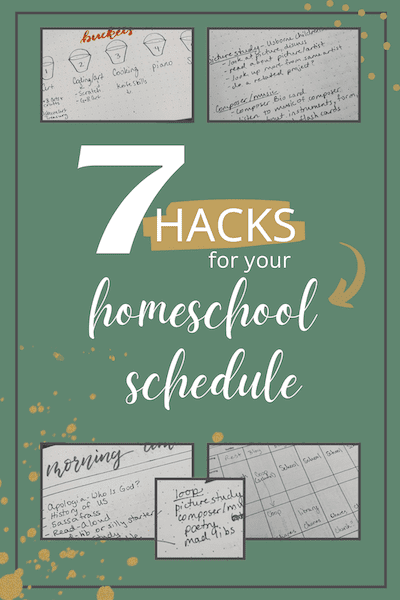
So sit back, take a breath, and keep reading for some hacks for your homeschool schedule that will save your sanity and help you get more done.

1. Use time blocking
Time blocking is a way to manage your schedule where you break your day or week into blocks of time. Within each time block, you assign a certain task and only that task. This can allow you to focus deeply on the task at hand. It may also be called block scheduling.
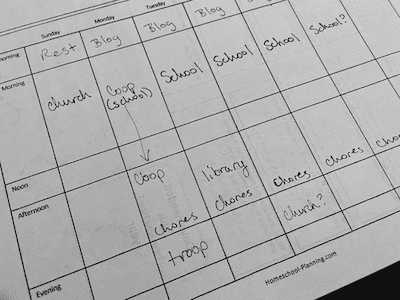
As a homeschooler, you could block out a few hours each day for school in the morning, and other things in the afternoon. You could also block out time by subject each day, or even time block 1-2 days a week for science and history, with other subjects the other days. There are many ways to use time blocking.
I have found this approach particularly helpful with messier subjects like art or science. This helps us be able to dive into science experiments and art without feeling rushed.
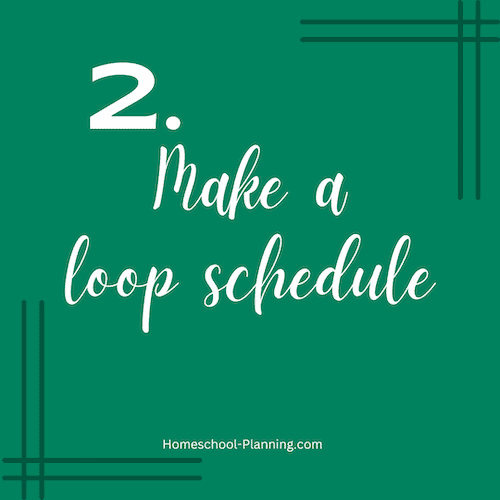
2. Make a loop schedule
A loop schedule is a way to approach a group of tasks or subjects within your homeschool. What makes it helpful is that you don’t have to complete the whole list at once. You work your way down the list until you decide to be done, then the next day, pick right up in the list where you left off. When you get to the end of the list, you loop back to the top and start over. And the process loops on.

A loop schedule is really helpful for morning time and those short subjects you want to get in each week but have a hard time getting to.
Subjects don’t have to be assigned by day and you shouldn’t feel “behind” as you always just pick up where you left off. You can even add a subject to the list more than once if you’d like to get to it more often.
An example of a loop schedule:
Bible
Manners
History
Shakespeare
Novel
On day 1, you may only get Bible and manners completed. Day 2, is History, and day 3 could be Shakespeare, novel, and Bible. Day 4 could be manners, history and Shakespeare, and day 5, novel, Bible, and history. And so on.

3. Integrate subjects
Integrating subjects can help your kids practice many subjects without taking as much time in the day. Not every subject needs in depth study each year.
Writing assignments can be done on historical topics. You could accomplish spelling, vocabulary, and handwriting all together with copywork assignments. There are great historical fiction books that can be used for literature, completing both history and literature.
Unit studies are a great example of combining subjects in homeschool. One overall topic is chosen – often a science or history topic. Students then learn about this topic while doing activities with elements of Math, English, Art, and other subject areas.
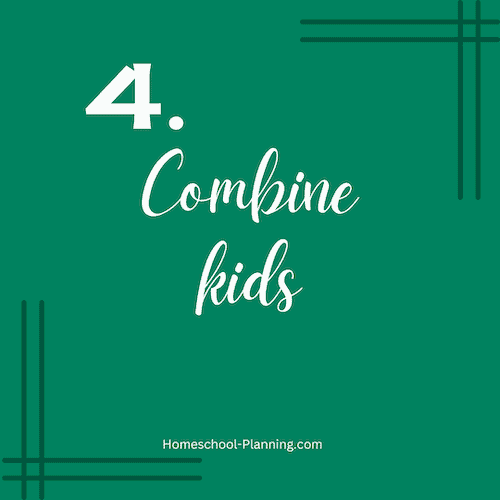
4. Combine kids
Combining your children on subjects can be a helpful way to free up some headspace for a homeschool mom. This means that instead of having 3 individual science books and topics for each of your children, you could choose one resource and teach all 3 of your children together.
If you have children close in age, this is very easily done for many subjects. Math might be the only area they do separately.
But if your kids are further apart in age, then subjects like history and science may be all you can easily do together. Young ones can watch while older children complete experiments. Of course different bookwork would be assigned by age level.
Think of it like a one room school house kind of feel. Unit studies often use this approach.

5. Do a morning time
Morning time is a part of your homeschool day where you can do all the lovely little things you want to do together. It can be a combination of several short activities, or a couple longer things, like history or science. The main idea is that it is done together. It may also be called circle time, loop time, or morning basket.
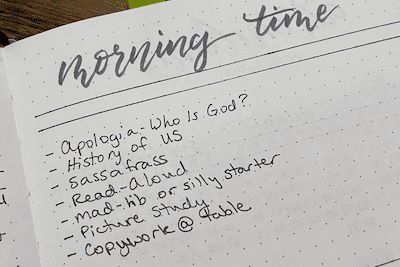
Some common ideas to include in your morning time:
- Bible reading
- Memorization
- Poetry
- Grammar
- Read alouds
- Music theory/appreciation
- Art appreciation/picture study
- Calendar
- Weather
- Science
- History
- Copywork
- Anything else you may want!
As our kids get older, it can become more difficult to get time with them as they become more independent students. Morning time can be a great way to connect and see all your children daily.
Read: Morning Basket Made Easy: Group Learning in Homeschool
There is no right or wrong way to do morning time. You definitely don’t have to be a Charlotte Mason homeschooler. It can be short, like 10 minutes, or over an hour. Morning time also doesn’t even have to be in the morning!
It can take time to figure out your groove. For more information on morning time, check out my post called Morning Basket Made Easy: Group Learning in Homeschool.
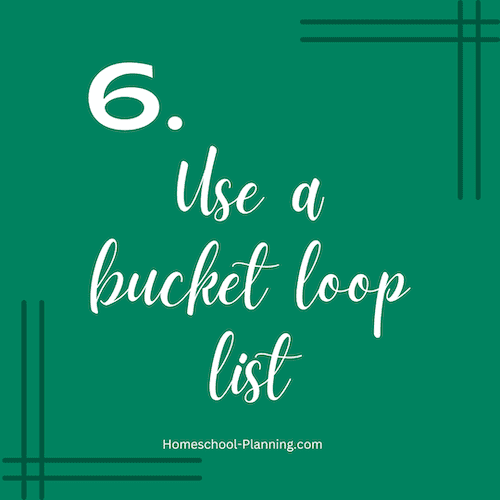
6. Use a bucket loop list
A bucket loop list is an advanced looping list for true list lovers. It’s a bit of a loop within a loop. If you have several loops you’d like to do in your homeschool, you could combine them into an overall bucket loop. This can help you get to everything you are wanting to teach.
If you haven’t read about a loop schedule yet, scroll back up to #2 above before continuing.

First you pick an overall category for each loop list – we’ll call those the buckets. Then within some or all of the buckets, create a looping list. You loop through the buckets, and also loop through the internal loops. Clear as mud?
You may choose to do only one bucket each day, looping through the activities included. Or you may choose to do one activity from each bucket on each pass, doing multiple buckets as time allows.
Here’s an example of a bucket loop list:
| Art bucket | Computer bucket | Read aloud | Music bucket | Science bucket |
| -Craft -Picture Study -Artist study | -Coding -Typing | -Bible -History -Poetry | -Theory -Composer study | -Reading -Nature walk -Experiment |
On the first pass through this bucket loop, you may do a craft, followed by coding, then Bible, Music theory, and science reading. Then it may be picture study, typing, History reading, composer study, and a nature walk.
If you can get the hang of a bucket loop list, this homeschool schedule hack can be an exciting way to change up learning throughout the week. You are able to touch a lot of areas of study in multiple ways.
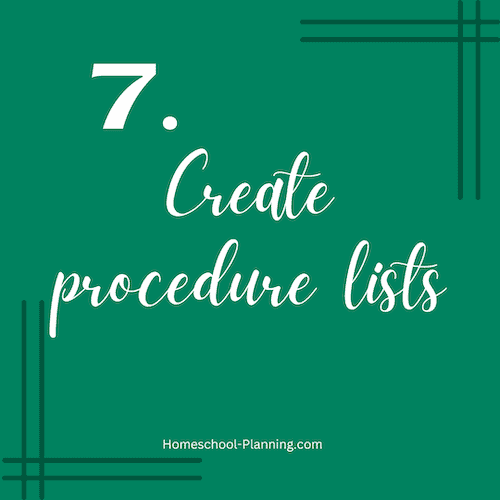
7. Create procedure lists
When putting together your own curriculum or pooling resources, a procedure list may be helpful. This is a list where you write out the procedure you use to approach the subject. This can be helpful by laying out your process in advance, reducing decisions in the moment. You could even loop it!

You probably use procedures in a lot of curricula already. For instance, All About Reading starts with word cards, then new learning, followed by an activity, new word cards, and further reading. This is the idea we are hoping to lay out, so you can turn any resource into an ‘open and go’ curriculum of sorts.
Many popular history resources have multiple steps involved and you may or may not want to do them all. You could choose to do these steps:
- Read a chapter
- Look up the country on the globe
- Narrate the chapter
- Discuss
- Add events to timeline
- Do one activity
With your procedure list in mind, you will not have to make as many decisions as you go through your day, saving time and brainpower.
Conclusion
So there you have it! Several homeschool schedule hacks you can add to your days to cover more and save your sanity. Implement these hacks and see how they work for you and your family. And as always, don’t forget to have fun along the way!
Do you have any other homeschool hacks you use in your schedule? We’d love to hear about them in the comments!
Related Posts
Everything you wanted to know about Homeschool Attendance Records
10 Ideas for Rough Homeschool Days
How to Plan your Homeschool Year
21 Productivity Tips



